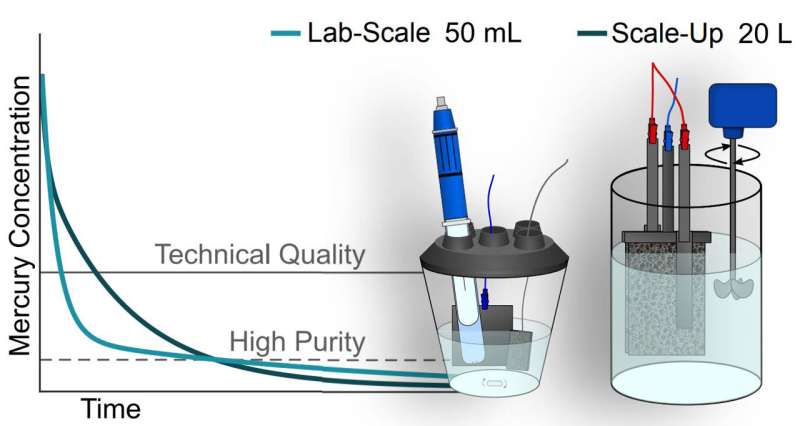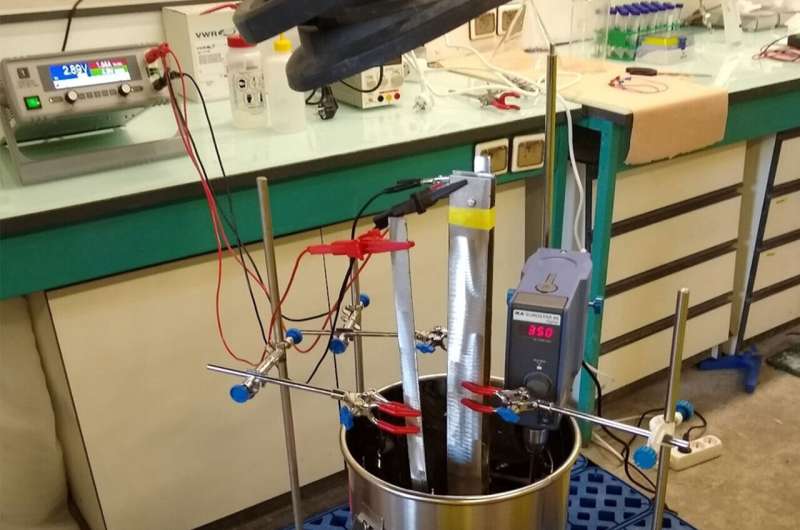This article has been reviewed according to Science X's editorial process and policies. Editors have highlighted the following attributes while ensuring the content's credibility:
fact-checked
trusted source
proofread
How mercury emissions from industry can be greatly reduced

Sulfuric acid is the world's most used chemical. It is an important reagent used in many industries and it is used in the manufacture of everything from paper, pharmaceuticals and cosmetics to batteries, detergents and fertilizers. It is therefore a worldwide challenge that sulfuric acid often contains one of the most toxic substances—mercury. Researchers at Chalmers University of Technology, Sweden, have now developed a method that can reduce the levels of mercury in sulfuric acid by more than 90%—even from low levels.
"Until now, there has been no viable method for purifying finished sulfuric acid at all. With such a radical reduction in the mercury content, we come well below the current limit values. Such pure high quality sulfuric acid is in high demand in industrial applications and an important step in reducing environmental impact," says research leader Björn Wickman, Associate Professor at the Department of Physics at Chalmers.
Sulfuric acid is produced either from sulfur from the petroleum industry or as a by-product in the mining industry's smelters. In the latter case, mercury, which is naturally present in the ore, can end up in the finished products. Also recycled streams in the smelters can contain mercury.
Toxic emissions that affect all life on Earth
Mercury dispersal is a worldwide problem, as the substance is volatile and can be dispersed by air over large areas. This toxic heavy metal is then washed into streams and lakes when it rains. It is stored in the soil, water and living organisms, impacting the entire food chain. It can damage the brains and central nervous systems of humans and animals.

According to a report from the United Nations Environment Program (UNEP), emissions of mercury to the atmosphere increased by an estimated 20% from 2010 to 2015.
In 2015, about 2,200 tons of mercury were emitted into the air as a result of human activities such as cement manufacture, small-scale gold mining, coal burning, metal production and other manufacturing industries. In addition, an estimated 1,800 tons of mercury ended up in the soil and water in that same year. According to the report, mercury concentrations in the atmosphere may have increased by 450% in the last century.
"Any and all ways we can reduce mercury emissions are good, because any mercury that is emitted accumulates in the environment and continues to pose a health threat for thousands of years," says Wickman.
Captures the metal using electrochemistry
Five years ago, his research team at Chalmers presented a pioneering method for removing mercury from water using electrochemical processes. The method is based on a metal electrode taking up the toxic metal and forming an alloy. The mercury can then be safely removed, and the electrode reused. Now the researchers have taken this technology one step further, and in a new study they have shown how mercury can be removed from concentrated sulfuric acid.
The experiments with sulfuric acid were done in collaboration with mining and metals refining company Boliden and the company Atium, a spin-off from the Chalmers School of Entrepreneurship with the aim of bringing the removal of mercury from water and chemicals to market. The researchers now hope to be able to move forward with their partners and develop a type of reactor through which sulfuric acid can flow and be purified at the same time.

Potential to reduce costs and environmental impact
Today, mercury is mostly removed at an earlier stage—from the concentrates and recycled streams at the smelter before sulfuric acid is produced. This is an established process, but leaves trace amounts of mercury into final products.
"Purifying the sulfuric acid as well prevents additional mercury emissions, while allowing industry to operate more cost-effectively and produce a high-purity, non-toxic product. The next step will be to scale up the method into a pilot process that is closer to real-world volumes of thousands of tons," says Vera Roth, doctoral student at Chalmers and first author of the article published in the journal ACS ES&T Engineering.
Hoping for lower limit values
According to the Statista database, the worldwide market volume for sulfuric acid amounts to around 260 million tons per year. By 2029, this figure is expected to rise to 314 million tons. The lower the mercury content of the sulfuric acid, the more valuable it is. Sulfuric acid for commercial purposes is considered to be of acceptable quality when its mercury content is below 0.30 milligrams per kilogram.
If the content is below 0.08 milligrams per kilogram, the sulfuric acid is considered to have a high purity. With the new method, the researchers have reduced the level of mercury to 0.02 milligrams per kilogram of sulfuric acid in their pilot study.
"The limit values for how much mercury sulfuric acid may contain are based on the technology available today. With the new method for purifying sulfuric acid, our hope is that the legislation around the limit values will be tightened in a global perspective where mercury levels are generally much higher," says Wickman.
More information: Vera Roth et al, Mercury Removal from Concentrated Sulfuric Acid by Electrochemical Alloy Formation on Platinum, ACS ES&T Engineering (2023). DOI: 10.1021/acsestengg.2c00417
Provided by Chalmers University of Technology





















